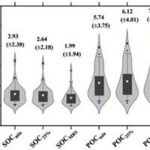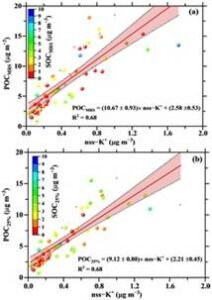
Mineral dust, biomass burning, secondary sulfate, secondary nitrate from northwest India and Pakistan, polluted cities like Delhi, the Thar Desert, and the Arabian Sea area, and long-range transported marine mixed aerosols are the main sources of aerosols in the central Himalayan region, shows a study. This dust transport and forest fires are the main sources of total suspended particles (TSP), particularly in pre-monsoon period (March-May) when TSP concentration peaks in the region. The study on source apportionment of atmospheric pollution, which elucidates the atmospheric chemistry, emission source origins, and transport pathways of aerosol over the central Himalayan region, will help assessment of contributions and temporal variability of sources that influence the area through regional transport as well as climate impacts assessment.

With a unique role in the Asian climate, the Himalayan region is considered a vulnerable environment. Several chemical speciation studies have been performed for carbonaceous aerosols and inorganic species over the western and central Himalayan regions during the last decade, reporting the dominance of transported aerosol plumes from the Indo-Gangetic Plains. However, there is a knowledge gap regarding the primary and secondary organic carbon (POC, SOC) fractions, along with a lack of statistical methods for identifying and quantifying the sources of air pollutants at a receptor location (receptor model) in the central Indian Himalaya. In order to address this, researchers at the Aryabhatta Research Institute of Observational Sciences (ARIES), Nainital, an autonomous research institute under the Department of Science and Technology (DST), Govt. of India, along with Indian and foreign collaborators, studied the chemical composition and source apportionment of total suspended particulate (TSP, which includes all the aerosols and air pollution) in the central Himalayan region. The main source regions for aerosols at this remote background location (Nainital) were the plains in northwest India and Pakistan, polluted cities like Delhi, the Thar Desert, and the Arabian Sea area.
The study led by Mr. Rahul Sheoran (Ph. D. Student ARIES, Nainital, India), Dr. Umesh Chandra Dumka (Scientist, ARIES, Nainital, India), along with the contributions by collaborators revealed that the main aerosol sources (factors) in Nainital were mineral dust (34%), biomass burning (27%), secondary sulfate (20%), secondary nitrate (9%), and long-range transported marine mixed aerosols (10%), exhibiting distinct seasonal patterns. There was predominance of mineral dust in spring and summer and biomass burning and secondary sulfate in winter. The transported marine mixed aerosol source was mainly associated with SW monsoon air masses during the summer season. The results of the study published in the journal of ‘Atmosphere show that Carbonaceous aerosols (Organic Carbon (OC) and Elemental Carbon (EC) were the maximum in winter due to the intensification of biomass burning over the Indo Gangetic Plains and the Himalayas because of domestic heating and shallower mixing layer. The researchers also suggested a significant effect of biomass-burning aerosols, while the relatively high water-soluble organic carbon and significant contributions of biomass burning, secondary, or aged organic aerosols over Nainital.

